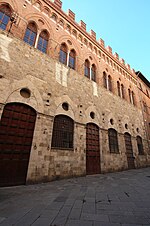San Pietro alle Scale, Siena

San Pietro alle Scale, also known as San Pietro in Castelvecchio is a Roman Catholic parish church located on via San Pietro, Terzo of Città, in Siena, region of Tuscany, Italy. Initially built in the 12th-century, this parish church was completely rebuilt in a Baroque style in the 17th century; the brick facade has a portal with a depiction of Glory of St Peter. The belltower dates to 1699, and the facade to 1706. Amid the interior’s elaborate stucco decoration, are the remains of a 14th-century polyptych by Ambrogio Lorenzetti, depicting a Madonna with Child and Saints; St Lucia and the Archangel Gabriel; The Redeemer blessing; Sts Peter and Paul; and a Female Saint and St Michael Archangel. The church also contains a Rest on the Flight to Egypt (1621) by Rutilio Manetti. An altar on the right has a canvas depicting Madonna in Glory by Francesco Rustici, and a canvas of St Roch and St Catherine of Siena by Ventura Salimbeni. This is one of two churches in Siena dedicated to St Peter, the other is the church of San Pietro alla Magione.
Excerpt from the Wikipedia article San Pietro alle Scale, Siena (License: CC BY-SA 3.0, Authors, Images).San Pietro alle Scale, Siena
Casato Di Sopra, Siena San Prospero
Geographical coordinates (GPS) Address External links Nearby Places Show on map
Geographical coordinates (GPS)
| Latitude | Longitude |
|---|---|
| N 43.315464 ° | E 11.330873 ° |
Address
San Pietro alle Scale
Casato Di Sopra
47065 Siena, San Prospero
Tuscany, Italy
Open on Google Maps











